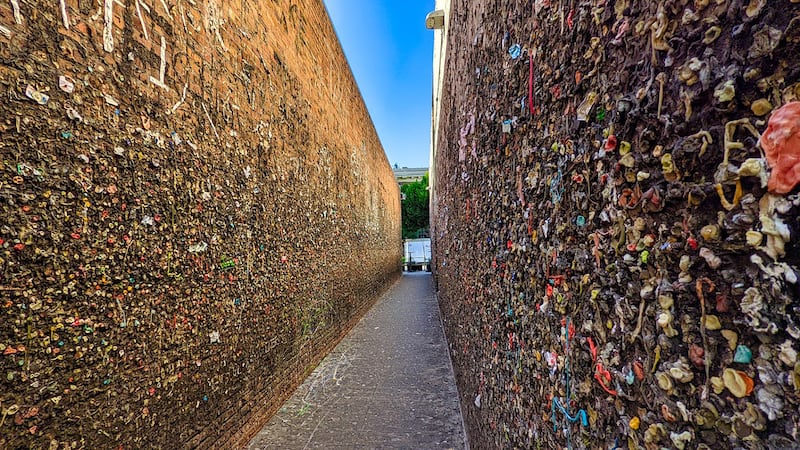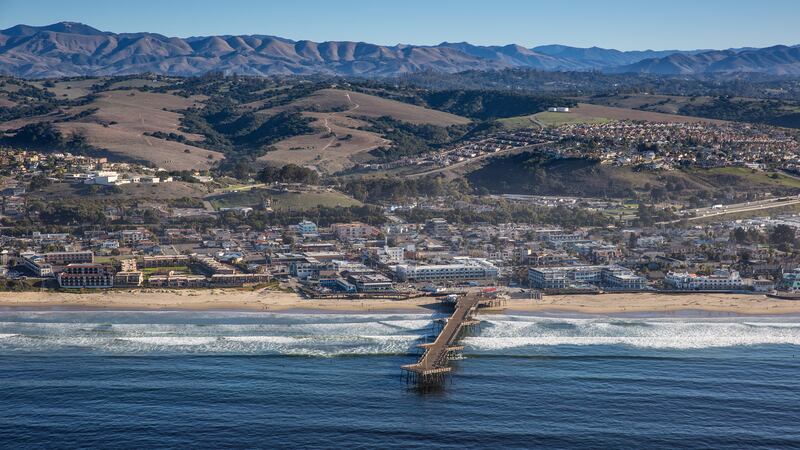Along California’s central coast, between Los Angeles and San Francisco, is San Luis Obispo, a charming city that rests along sloping green hills. Known as SLO, it is ready for any number of “so” or “slow” puns—like the city’s mural which says, “SLO Irresistible.”
But SLO is also known for something else: its fight against climate change.
At the invitation of their tourism offices, I spent three days seeing how sustainability is done in the city—visiting sustainable hotels, restaurants, wineries, and an organic waste plant—because no sustainability trip is complete without seeing compost. What I discovered is that SLO is anything but SLOw (see what I did there?) when it comes to its climate goals.
While most of us travel for historic sites, great shopping, or gastronomy, not enough of us travel based on sustainability, which is why San Luis Obispo is the latest selection for The Daily Beast’s travel series on underrated travel, It’s Still a Big World.
When it comes to climate change, scientists have laid out scenarios for how bad things can get if temperatures rise by 1.5 degrees Celsius or higher—the limit set by the Paris Agreement, an international treaty on climate change signed in 2015. The verdict is still out on whether we can pull it off, which is why on every Earth Day your social feeds are a confused mess of hope and doom. According to the latest report from the United Nations Intergovernmental Panel on Climate Change, we need drastic climate action now, cutting emissions by nearly half by 2030 to reach the goal of being net zero by 2050.
That’s where cities like San Luis Obispo come in. They aim to achieve net zero by 2035, a goal that will have beaten California’s same goal by 10 years.
What’s special about SLO?
First, there are many reasons to visit SLO outside of its sustainability efforts. They have the quirky, like their Bubblegum Alley, which is covered in bubble gum (and likely your COVID nightmares), great local food, the outdoors, and opportunities to just kick back and relax.

Bubblegum Alley in downtown San Luis Obispo.
Brandon WithrowDowntown SLO has plenty of sustainable food options that are farm-to-table and locally-sourced, like the menu at Seeds, Mint + Craft, or Big Sky Café. Whenever I’m traveling, finding a good breakfast is top on my list, and the last two are great starting places. If you're like me, and sometimes you just want a hearty breakfast sandwich, try Mint + Craft’s The Original Sando, which is a folded egg and sharp cheddar served on a house-baked biscuit—definitely add either the cayucos hot sauce aioli or the cambria avocado.
Big Sky Café is a nice open space with a patio area. It is a long-established farm-to-table restaurant with a menu made for food lovers. For breakfast, I recommend the Chile Verde Omelet and New Orleans Beignets. (To be honest, though, I always recommend beignets. I am helpless against beignets.)
Coffee shops can be found around every corner. And if you’re looking for a great beer after being out hiking, I would visit Antigua Brewing, which brews using locally grown hops. For dinner, you can’t beat the paella on the patio at Luna Red, which comes with a view of the park and Mission San Luis Obispo.
If you’re an ecotourist at heart, bring your hiking shoes, because a short walk up the trails of Terrace Hill in the middle of SLO provides a panoramic view of the city and its sloping green hills, as well as conserved land that is ready to be explored.
Many of those hills are also part of the Nine Sisters—volcanic peaks that are strung out between San Luis Obispo and Morro Bay. Don’t worry, they’re dormant. Seven of those, referred to as the Seven Sisters (named after The Pleiades) are public and open for hiking. From Terrace Hill you can easily see two of them: Cerro San Luis and Bishop Peak.
You can also cycle the city.
There are places to rent bikes and some hotels provide complimentary access to bikes. As bikes are key to reducing emissions, bike advocacy is big in SLO, and the county itself has what is called the Bike Kitchen to educate and help others fix or build a bike. A recent grant of $2.5 million is enabling the city to begin a bicycle and pedestrian project in 2022.
And if you’re there to relax, from SLO there is easy access to Pismo Beach (known for its Clam Festival in the fall), Avila Beach (known for its charm and natural hot springs), and Morro Bay (home to Morro Rock, the last of the Nine Sisters). You can also find Spas, like SLOCO Health + Wellness, where I spent some time in a meditation chamber, or if you’re into yoga, visit The Center SLO, where I enjoyed a slow yoga class in front of a beautiful view.
My main goal for being in SLO, though, was to see how sustainability plays out in the city.
My home for the trip was the 65-room Hotel Cerro, a luxury eco-hotel located in downtown SLO that is focused on sustainability. Eight of their 65 rooms are long-term housing options, provided as part of an agreement with SLO to create housing within the city.
What does a sustainable hotel look like?
Hotel Cerro is built to meet LEED silver certification—a program recognized as the standard measure for green, sustainable buildings. There are electric vehicle charging stations, no single-use plastics, a wellness spa, which uses organic, responsibly sourced, and cruelty free products, complimentary bike access, automated thermostat setback, and guests are provided reusable water bottles and access to fill stations throughout the property. Their restaurant, Brasserie SLO, provides coastal cuisine and sources its organic food locally from the central coast.
Hotel Cerro’s garden suites ($450+ USD) are spacious and welcoming rooms, with plenty of seating, an open bath that has a free-standing bathtub that uses a ceiling fill feature, a large walk-in shower, and private balconies or private patios, with fire pits and direct access to an edible garden. Guests are encouraged to pick vegetables and fruit from the garden. The design of the building keeps rooms from facing the street, leaving the balconies and patios quiet. Even the rooftop pool, with its cabanas, bar, and view of the hills, feels less like a city rooftop and more like a getaway.
Hotels in SLO are also active participants in the city’s sustainability goals.
SLO created an urban reforestation initiative—“Keys for Trees”—funded by hotel stays that goes toward planting 10,000 new trees, aimed at helping the city to meet their carbon neutral goals.

Among their many programs, the city also started the Clean Energy Choice program in 2020, providing access to carbon-free electricity. The program requires zero-net emissions for all new buildings, which must also be all-electric, rather than using mixed fuel. The program will be continually updated with incentives to reduce emissions in existing buildings, including having a “carbon-neutral government operations by 2030.” They are also adding more electric vehicle charging stations and working to conserve more land.
But what I really loved seeing in SLO is the KOMPOGAS Anaerobic Digester, which turns organic waste from residents and businesses into compost for the community, also using the methane of organic waste to produce renewable energy.
As a gardener, I have a regular supply of compost going at home. All of my organic waste goes there, rather than a landfill, and I use it to grow my vegetable garden each year. SLO does this as a city. Businesses and residents in the program are provided green bins to collect their organics and supply the Anaerobic digester.
Farming and gardening is also big in SLO.
One morning, we made our way to City Farm SLO, a wonderful green space lined with crops, which (during my visit) was also under a beautiful blue sky. When I left home in Ohio it was 20 degrees and gray, so I was happy for every good-weather moment I could find.
City Farm SLO is the hub of sustainable agriculture. It is also an educational place—as part of our tour we got our fingers dirty and learned how to harvest lettuce. It is also where students from California Polytechnic State University (Cal Poly) agriculture program learn to grow sustainable crops.
City Farm is also part of the Farm Trail created by FARMstead ED. The trail is a feature of the area’s growing agritourism market, and it includes farming experiences and workshops for learning farmsteading skills. Every Thursday, many of those farms make their way to Higuera Street, where 80 to 100 vendors setup at the Downtown SLO Farmers’ Market—said to be the second largest farmers’ market in the United States.

The pier and downtown Pismo Beach in California.
George Rose/Getty ImagesBut if your type of crop is a wine grape, then head over to the Edna Valley, home to chardonnays and pinot noirs, and where you can tour Sustainability in Practice (SIP) Certified wineries. So while you’re drinking your weekend away, you can do it knowing that you may hurt your liver, but you won’t hurt the planet.
I was able to visit Tolosa Winery and Wolff Vineyards in the valley. Tolosa is a newer winery with a modern feel and a fantastic selection of wines. The winery is in a beautiful setting, though the tasting room outside is more of an open seating area, near a section of vines that had been recently removed.
Wolff Vineyards has a stunning outdoor tasting space, with umbrella seating, a vibrant flower garden, and an expansive view of the vineyard and Islay Hill in the distance (one of the Seven Sisters). The vineyard works hard to keep its 125 acres ecologically sustainable, like a water delivery system that goes to the roots of the plants. (Chardonnays are not my thing, but I did enjoy their pinot noir, with its notes of strawberry and black cherry.)
For tourists who pledge to park their vehicles and go carfree while visiting—which might be good if you’re doing the winery tours—the county and city provide incentives from participating hotels, restaurants, transportation services, and attractions.
Sustainability and tourism are crucial partners. That is why the United Nations World Tourism Organization announced the UN Fund for the Climate Neutrality of Tourism last year, with the hope of pushing for the decarbonization of tourism. Cities like San Luis Obispo appear to be ahead of the curve.
Of course, being in San Luis Obispo for three days isn’t like taking a deep dive into everything they do. It is hard to just drop in and declare them unequivocally “SLO sustainable,” or some pun like it. Even so, SLO does wear their environmentalism on their sleeves. That is probably why they made the A-List for the Climate Disclosure Project, a non-profit that tracks cities for their transparency and climate action plan.
But even that is telling. Only 95 cities have made that list globally, and yet we still hope to achieve the goals of the Paris Agreement. In other words, even if San Luis Obispo makes it to carbon neutrality by 2035, we’re still probably going to need a lot more SLOs.

